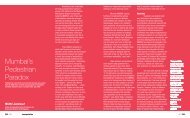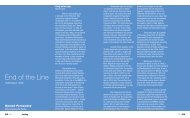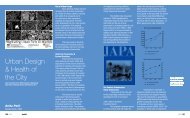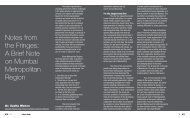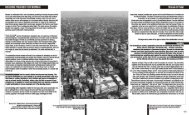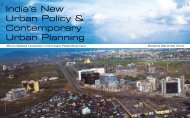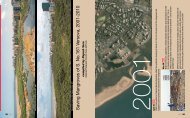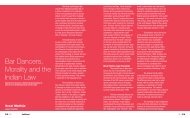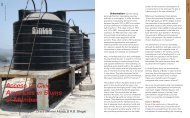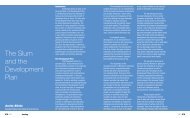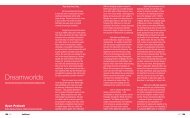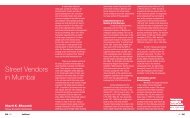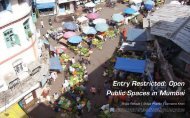Traffic Congestion in Mumbai: Will public authorities take the ...
Traffic Congestion in Mumbai: Will public authorities take the ...
Traffic Congestion in Mumbai: Will public authorities take the ...
Create successful ePaper yourself
Turn your PDF publications into a flip-book with our unique Google optimized e-Paper software.
400<br />
<strong>Traffic</strong> <strong>Congestion</strong> <strong>in</strong><br />
<strong>Mumbai</strong>: <strong>Will</strong> <strong>public</strong><br />
Authorities <strong>take</strong> <strong>the</strong><br />
Opportunity to Leapfrog?<br />
_Gaële Lesteven<br />
401
TRANSPORT | 402<br />
<strong>Traffic</strong> congestion <strong>in</strong> <strong>Mumbai</strong><br />
When one th<strong>in</strong>ks of <strong>Mumbai</strong>, what <strong>in</strong>evitably<br />
comes to m<strong>in</strong>d are images of overcrowded<br />
tra<strong>in</strong>s or queues of cars and yellow-black taxis,<br />
bumper to bumper, constantly honk<strong>in</strong>g. A s<strong>in</strong>gle<br />
word to characterise <strong>the</strong> situation is saturation.<br />
If 60% of <strong>the</strong> 20.8 million <strong>in</strong>habitants of <strong>Mumbai</strong><br />
Metropolitan Region (MMR) walk, <strong>the</strong>n half<br />
of <strong>the</strong> people us<strong>in</strong>g motorised modes <strong>take</strong><br />
<strong>the</strong> tra<strong>in</strong> (MMRDA, 20081). S<strong>in</strong>ce <strong>the</strong> 1970s,<br />
<strong>the</strong> population has tripled but <strong>the</strong> railway<br />
network has rema<strong>in</strong>ed more or less <strong>the</strong> same.<br />
Thanks to <strong>the</strong> <strong>Mumbai</strong> Urban Transport Project<br />
(MUTP), directed by <strong>the</strong> <strong>Mumbai</strong> Metropolitan<br />
Region Development Authority (MMRDA) with<br />
World Bank assistance, <strong>the</strong> network has been<br />
recently upgraded with new carriages and<br />
new tracks but <strong>the</strong> situation is still worsen<strong>in</strong>g.<br />
In peak hours, commuter density is up to 16<br />
persons per square meter (MMRDA, 2008).<br />
Travel growth is ma<strong>in</strong>ly concentrated <strong>in</strong> road<br />
trips. The 140% <strong>in</strong>crease <strong>in</strong> cars, plus a 300%<br />
<strong>in</strong>crease <strong>in</strong> two-wheelers, a 420% <strong>in</strong>crease <strong>in</strong><br />
auto-rickshaws & a 130% <strong>in</strong>crease <strong>in</strong> taxis dur<strong>in</strong>g<br />
1991-2005 has <strong>in</strong>creased traffic congestion<br />
(MMRDA, 2008). Never<strong>the</strong>less, with 5,30,000<br />
cars among <strong>the</strong> 1.7 million motorised vehicles<br />
<strong>in</strong> Greater <strong>Mumbai</strong> 2 , car density is still low (33<br />
cars per <strong>in</strong>habitants). 7% of motorised trips<br />
are made by car, 7% also by two-wheelers<br />
and 9% by taxi & auto-rickshaws (MMRDA,<br />
2008). Car use <strong>in</strong>creases with <strong>in</strong>come but tra<strong>in</strong>s<br />
still compete with cars & two-wheelers for<br />
longer distances. Baker (2005) noticed that<br />
<strong>in</strong> Greater <strong>Mumbai</strong>, 24% of commuters with<br />
a household <strong>in</strong>come higher than 20,000 Rs<br />
per month use a car (3% <strong>in</strong> general) & 20% a<br />
two-wheeler; 21% still <strong>take</strong> <strong>the</strong> tra<strong>in</strong>. MMRDA<br />
(2008) reported that <strong>in</strong> MMR, 18% of commuters<br />
with a household <strong>in</strong>come higher than Rs<br />
30,000 per month use a car (2% <strong>in</strong> general)<br />
&10% a two-wheeler; 36% still <strong>take</strong> <strong>the</strong> tra<strong>in</strong>.<br />
Table 1 General socio-economic data for MMR<br />
Data MMR<br />
Population (millions of <strong>in</strong>habitants) 20.8<br />
Area (km 2 ) 4.353<br />
Mobility (trips/<strong>in</strong>habitant) 1.65<br />
Mobility (motorised trips/<strong>in</strong>habitant) 0.65<br />
Trips/day/modes (million) 34.3<br />
Traveled distance per day (million - km) 250<br />
<strong>Traffic</strong> congestion<br />
<strong>Traffic</strong> congestion occurs when supply<br />
cannot satisfy demand. It is characterised<br />
by low average travel speed dur<strong>in</strong>g peak<br />
periods. S<strong>in</strong>ce 1962, <strong>the</strong> m<strong>in</strong>imum average<br />
speed has been decreas<strong>in</strong>g a lot: From 18<br />
kmph to 8 kmph <strong>in</strong> Island city and from 30<br />
to 5 kmph <strong>in</strong> <strong>the</strong> suburbs. This higher speed<br />
range between m<strong>in</strong>imum speeds at peak<br />
periods and maximum speeds at off-peak<br />
periods results <strong>in</strong> an <strong>in</strong>crease of travel time<br />
variability. More and more <strong>Mumbai</strong>kars have<br />
<strong>the</strong> feel<strong>in</strong>g that <strong>the</strong>y cannot time <strong>the</strong>mselves.<br />
Table 2 Travel speeds (kmph) <strong>in</strong> MMR<br />
Wilbur Smith<br />
Associates,<br />
1962<br />
Central Road<br />
Research<br />
Institute,1983<br />
LEA<br />
International<br />
Ldt, 2008<br />
Island city 18 to 25 18 to 25 8 to 30<br />
Suburbs 30 to 40 30 to 40 5to 45<br />
MMR 30 to 50 35 to 45 25 to 55<br />
Passenger car unit (PCU) is used to measure<br />
heterogeneous traffic volume and variation.<br />
One car is converted <strong>in</strong>to 1 PCU; 1 taxi <strong>in</strong>to 1<br />
PCU, 1 rickshaw <strong>in</strong>to 0.8 PCU, 1 two-wheeler<br />
<strong>in</strong>to 0.5 PCU and 1 bus <strong>in</strong>to 3 PCU. <strong>Traffic</strong> is<br />
dense dur<strong>in</strong>g almost <strong>the</strong> whole day with a slight<br />
off-peak period around lunch time (figure 1).<br />
Figure 1 <strong>Traffic</strong> variation (total <strong>in</strong> PCUs),<br />
MMRDA, 2008.<br />
<strong>Traffic</strong> congestion ma<strong>in</strong>ly occurs dur<strong>in</strong>g<br />
peak hours, southbound <strong>in</strong> <strong>the</strong> morn<strong>in</strong>g and<br />
northbound <strong>in</strong> <strong>the</strong> even<strong>in</strong>g. People go to work <strong>in</strong><br />
<strong>the</strong> Island city and go back home <strong>in</strong> <strong>the</strong> suburbs.<br />
With <strong>the</strong> development of new bus<strong>in</strong>ess centres<br />
such as Bandra-Kurla-Complex or Andheri-Kurla<br />
Road, <strong>the</strong> suburbs have begun to offer more<br />
jobs. The MMR urban structure is chang<strong>in</strong>g:<br />
Figure 1<br />
If <strong>the</strong> population has rema<strong>in</strong>ed <strong>the</strong> same <strong>in</strong><br />
Island city s<strong>in</strong>ce 1971, it has grown a lot <strong>in</strong> <strong>the</strong><br />
suburbs and fur<strong>the</strong>r districts, where hous<strong>in</strong>g<br />
rema<strong>in</strong>s affordable for <strong>the</strong> middle-class (41%<br />
of MMR population lives <strong>in</strong> slums) and job<br />
opportunities are grow<strong>in</strong>g. The centre of<br />
gravity is mov<strong>in</strong>g towards <strong>the</strong> suburbs. Until<br />
<strong>the</strong> beg<strong>in</strong>n<strong>in</strong>g of <strong>the</strong> 2000s, 80% of commute<br />
trips were southbound. Nowadays, <strong>the</strong> figure<br />
has dropped to 60%. Rails still assure <strong>the</strong> major<br />
part of commute trips but local government<br />
has started to build roads (Balakrishnan,<br />
<strong>in</strong>terview 04/09/10). <strong>Traffic</strong> jams are important<br />
<strong>in</strong> westbound and eastbound where rail<br />
transport does not exist. The worst part of <strong>the</strong><br />
MMR <strong>in</strong> terms of traffic jams is <strong>the</strong> western<br />
suburbs where travel speed drops to 5 km/h.<br />
Table 3 Urban growth <strong>in</strong> Greater<br />
<strong>Mumbai</strong>: Hous<strong>in</strong>g and job localization<br />
Employment<br />
<strong>in</strong> <strong>the</strong> formal<br />
sector<br />
(In millions),<br />
Population (In millions) MMRDA<br />
2008<br />
Census<br />
1971<br />
Census<br />
2001<br />
Growth<br />
%<br />
2005<br />
Island city 3.07 3.34 109 % 2.20<br />
Western suburbs 1.71 5.13 300 % 2.18<br />
Eastern suburbs 1.20 3.51 290 % 1.00<br />
Total Greater<br />
<strong>Mumbai</strong><br />
5.98 11.98 200 % 5.38<br />
<strong>Traffic</strong> congestion is ma<strong>in</strong>ly due to <strong>the</strong> rapid<br />
growth <strong>in</strong> motorisation, while <strong>the</strong> road network<br />
has not changed much <strong>in</strong> 4 decades. This rapid<br />
growth <strong>in</strong> motorisation can be expla<strong>in</strong>ed by<br />
<strong>the</strong> extreme saturation <strong>in</strong> <strong>public</strong> transport, <strong>the</strong><br />
lack of efficient <strong>public</strong> transport <strong>in</strong> <strong>the</strong> eastwest<br />
l<strong>in</strong>ks and by <strong>in</strong>come growth, especially<br />
s<strong>in</strong>ce <strong>the</strong> 1991 economic liberalisation.<br />
Cars are becom<strong>in</strong>g cheaper items compared<br />
to o<strong>the</strong>r goods such as hous<strong>in</strong>g, and central<br />
government encourages its ownership<br />
(Datar, <strong>in</strong>terview 03/16/10). Moreover,<br />
70% of car owners can afford a driver who<br />
relieves <strong>the</strong>m of traffic and park<strong>in</strong>g problems<br />
(data from MESN). At <strong>the</strong> same time, local<br />
government has not managed to control<br />
urban decentralisation, which has given birth<br />
to suburbs without a real urban design.<br />
Consequently, average trip distances have been<br />
<strong>in</strong>creas<strong>in</strong>g, mak<strong>in</strong>g walk<strong>in</strong>g and cycl<strong>in</strong>g less<br />
feasible than before and thus encourag<strong>in</strong>g a<br />
shift from non-motorised to motorised modes.<br />
Comb<strong>in</strong>ed with slower travel speeds, suburban<br />
sprawl has greatly <strong>in</strong>creased average travel time<br />
(Pucher, 2007). This aggressive environment<br />
for pedestrians and cyclists encourages <strong>the</strong>m<br />
to buy a two-wheeler and <strong>the</strong>n a car as soon as<br />
<strong>the</strong>y can afford it (Tiwari, <strong>in</strong>terview 19/03/10).<br />
There are also more specific causes like<br />
encroachments, mixed traffic, lack of traffic<br />
discipl<strong>in</strong>e, lack of network hierarchy, railway level<br />
cross<strong>in</strong>gs, processions and religious events.<br />
How do <strong>public</strong> <strong>authorities</strong><br />
face traffic congestion?<br />
Not <strong>the</strong> ma<strong>in</strong> issue but a major one<br />
Transportation followed water shortages and<br />
<strong>the</strong> high cost of liv<strong>in</strong>g as critical issues for <strong>the</strong><br />
10,000 <strong>Mumbai</strong>kars, <strong>the</strong> H<strong>in</strong>dustan Times –<br />
Ipsos Indica Research surveyed (2010) but<br />
<strong>in</strong>frastructure did emerge as one of <strong>the</strong> top two<br />
issues for <strong>the</strong> city’s future, just beh<strong>in</strong>d education.<br />
The question of <strong>in</strong>frastructure related to traffic<br />
TRANSPORT | 403
TRANSPORT | 404<br />
congestion was first po<strong>in</strong>ted out <strong>in</strong> <strong>the</strong> 1962<br />
Bombay <strong>Traffic</strong> and Transportation Study; this<br />
topic was recurrent <strong>in</strong> <strong>the</strong> o<strong>the</strong>r comprehensive<br />
transportation studies (1983, 1992, 2008).<br />
How does local government deal with a rapid<br />
<strong>in</strong>crease <strong>in</strong> motorisation and traffic congestion?<br />
Is upgrad<strong>in</strong>g <strong>in</strong>frastructure <strong>the</strong> solution?<br />
Policies towards supply<br />
The traditional eng<strong>in</strong>eer<strong>in</strong>g answer to traffic<br />
congestion is build<strong>in</strong>g new roads. <strong>Mumbai</strong><br />
adopted this strategy <strong>in</strong> <strong>the</strong> 1990s economic<br />
liberalisation. This strategy was re<strong>in</strong>forced <strong>in</strong><br />
<strong>the</strong> 2000s with <strong>the</strong> desire to become a ‘worldclass’<br />
city on <strong>the</strong> Shanghai model (Bombay<br />
First, 2003). It has been implemented through<br />
two ma<strong>in</strong> MMRDA-World Bank projects: The<br />
road component of MUTP and <strong>the</strong> <strong>Mumbai</strong><br />
Urban Infrastructure Project (MUIP). East-West<br />
l<strong>in</strong>ks, such as <strong>the</strong> Jogeshwari Vikroli L<strong>in</strong>k Road,<br />
were developed to connect Western Express<br />
Highway and Eastern Express Highway <strong>in</strong> <strong>the</strong><br />
suburbs. The tolled Seal<strong>in</strong>k Bridge was built to<br />
decongest Mahim and Dadar neighborhoods<br />
and to re<strong>in</strong>force connectivity between Island<br />
city, <strong>the</strong> suburbs and <strong>the</strong> airport. 50 new<br />
flyovers were added along with 20 skywalks<br />
to create more homogeneous traffic. O<strong>the</strong>r<br />
metropolitan projects are under process like<br />
<strong>the</strong> extension of <strong>the</strong> Eastern Freeway, <strong>the</strong><br />
construction of a trans-harbour l<strong>in</strong>k between<br />
<strong>the</strong> pen<strong>in</strong>sula and Navi <strong>Mumbai</strong> and <strong>the</strong><br />
prolongation of <strong>the</strong> Seal<strong>in</strong>k to Nariman Po<strong>in</strong>t.<br />
Some efforts <strong>in</strong> traffic management have<br />
been made (Barvé, <strong>in</strong>terview 05/04/10). The<br />
<strong>Mumbai</strong> <strong>Traffic</strong> Police has implemented traffic<br />
lights (with real time management) <strong>in</strong> Island<br />
city. Results are still limited: Due to <strong>the</strong> lack<br />
of traffic discipl<strong>in</strong>e, police officers smoo<strong>the</strong>n<br />
traffic flow at ma<strong>in</strong> <strong>in</strong>tersections dur<strong>in</strong>g peak<br />
periods 3 . For <strong>the</strong> moment, MMRDA officials<br />
do not believe <strong>in</strong> traffic management as a<br />
mitigation tool on <strong>the</strong> metropolitan scale<br />
(Murthy, <strong>in</strong>terview 03/17/10). This po<strong>in</strong>t of<br />
view differs from <strong>the</strong> current American and<br />
European conception of traffic regulation, which<br />
tries to ally efficiency with low <strong>in</strong>vestment.<br />
Policies towards demand<br />
<strong>Mumbai</strong> is well known for its excellent rail<br />
and bus systems (BEST). Public <strong>authorities</strong> are<br />
work<strong>in</strong>g on eas<strong>in</strong>g overcrowd<strong>in</strong>g <strong>in</strong> tra<strong>in</strong>s and<br />
buses through MUTP. They also use MUTP<br />
as a framework for develop<strong>in</strong>g new mass<br />
transport projects. The elevated metro should<br />
be ready soon and will l<strong>in</strong>k Eastern suburbs<br />
to Western suburbs. A monorail is under<br />
construction. Like <strong>the</strong> metro, it is designed<br />
to reduce traffic congestion. Some activists<br />
deplore <strong>the</strong> lack of low-cost <strong>public</strong> transport<br />
options such as BRT, which is cheaper and<br />
rapidly available (Badami, 2006). Policies<br />
encourag<strong>in</strong>g modal shift are not followed<br />
by car use restrictions such as regulations<br />
on car ownership and park<strong>in</strong>g or toll<strong>in</strong>g<br />
schemes. Never<strong>the</strong>less, plann<strong>in</strong>g documents<br />
(MMRDA, 2008) address <strong>the</strong>se options.<br />
Evaluation of <strong>public</strong> policies & <strong>the</strong>ir future.<br />
What is <strong>the</strong> future for <strong>Mumbai</strong>? <strong>Will</strong> <strong>the</strong><br />
megacity succeed <strong>in</strong> be<strong>in</strong>g a ‘world-class’<br />
city, avoid<strong>in</strong>g a total collapse by efficient<br />
traffic regulations and without disconnect<strong>in</strong>g<br />
millions of citizens from <strong>the</strong>ir city?<br />
We make some suggestions to be distilled<br />
<strong>in</strong> <strong>the</strong> development plan process.<br />
1. Do not look West: build<strong>in</strong>g roads is not <strong>the</strong><br />
only way to become a ‘world-class’ city.<br />
From a technical po<strong>in</strong>t of view, build<strong>in</strong>g new<br />
roads is often <strong>in</strong>efficient because “roadway<br />
expansion generates <strong>in</strong>creas<strong>in</strong>gly more traffic,<br />
so that any congestion relief is temporary”<br />
(Downs, 2004). From a social po<strong>in</strong>t of view, it<br />
presents <strong>the</strong> risk of disconnect<strong>in</strong>g <strong>the</strong> motorised<br />
happy few from millions of <strong>in</strong>habitants (Anand,<br />
2006) and widen<strong>in</strong>g <strong>in</strong>equalities (Zérah, 2008).<br />
Baviskar (2010) denounces “middle-class<br />
efforts at champion<strong>in</strong>g <strong>the</strong> <strong>public</strong> <strong>in</strong>terest<br />
image credit_ Ranjit Kandalgaonkar<br />
by clean<strong>in</strong>g up city streets” by<br />
remov<strong>in</strong>g hawkers, beggars, cows,<br />
carts, pedestrians…, even if “<strong>the</strong>y<br />
are subverted by its own toxic<br />
enchantment with <strong>the</strong> automobile”.<br />
The city-damag<strong>in</strong>g effects of car<br />
traffic are known <strong>in</strong> European cities.<br />
These cities now try to restrict car<br />
traffic and promote pedestrians,<br />
cycl<strong>in</strong>g and <strong>public</strong> transport.<br />
Mayor Delanöe wants to close a<br />
2-kilometer stretch on <strong>the</strong> Left<br />
bank and slow traffic on <strong>the</strong> right<br />
bank <strong>in</strong> order to transform <strong>the</strong><br />
whole area <strong>in</strong>to a “pretty urban<br />
boulevard”, as he said, with cars<br />
and pedestrians coexist<strong>in</strong>g among<br />
cafes, flowers and float<strong>in</strong>g islands<br />
(Loftus, 2004). It appears essential<br />
to preserve this mixed traffic that<br />
characterises Indian streets.<br />
2. Look East or cont<strong>in</strong>ue<br />
to be a city of <strong>public</strong><br />
transport: Copy Hong Kong,<br />
S<strong>in</strong>gapore and Tokyo.<br />
How?<br />
a. By revers<strong>in</strong>g <strong>the</strong> traditional “law”<br />
of <strong>in</strong>creas<strong>in</strong>g <strong>in</strong>come result<strong>in</strong>g<br />
<strong>in</strong> a growth of car ownership.<br />
Two city-states, S<strong>in</strong>gapore and<br />
Hong Kong, demonstrate that<br />
<strong>the</strong> <strong>in</strong>crease of <strong>in</strong>come can be<br />
dissociated from <strong>the</strong> <strong>in</strong>crease<br />
of car ownership. In o<strong>the</strong>r<br />
words, <strong>the</strong> American way of<br />
transport solutions is not a fate.<br />
b. By restra<strong>in</strong><strong>in</strong>g car use. Park<strong>in</strong>g<br />
is a major issue. One can<br />
imag<strong>in</strong>e people pay<strong>in</strong>g for<br />
on-street park<strong>in</strong>g, as some<br />
NGOs have suggested (MESN).<br />
S<strong>in</strong>gapore has gone fur<strong>the</strong>r with<br />
car ownership restrictions.<br />
TRANSPORT | 405
TRANSPORT | 406<br />
c. By constantly promot<strong>in</strong>g <strong>public</strong> transport,<br />
not only rail <strong>public</strong> transport (tra<strong>in</strong>, metro,<br />
monorail) but also surface <strong>public</strong> transport.<br />
“To make <strong>public</strong> transport efficient, car<br />
traffic needs congested roads. <strong>Traffic</strong> jams<br />
without <strong>public</strong> transport are relatively<br />
useless. Public transport without traffic jams<br />
will never be efficient. <strong>Traffic</strong> jams have to<br />
be used as a tool for an efficient surface<br />
<strong>public</strong> transport” (Knoflacher, 2007).<br />
An <strong>in</strong>formal system of <strong>public</strong> transport has<br />
already been develop<strong>in</strong>g to face traffic<br />
congestion. This system is more competitive<br />
and more localised. For example, <strong>the</strong> <strong>Mumbai</strong><br />
municipal bus company (BEST) tests new<br />
it<strong>in</strong>eraries <strong>in</strong>stead of do<strong>in</strong>g long and expensive<br />
orig<strong>in</strong>-dest<strong>in</strong>ation surveys. At Churchgate<br />
Railway Station, a BEST employee estimates<br />
<strong>the</strong> demand and constantly adapts bus<br />
frequency. New AC Volvo buses on Bandra-<br />
Navi <strong>Mumbai</strong> l<strong>in</strong>e replaced uncomfortable old<br />
buses (Joshi, <strong>in</strong>terview 04/15/10). Examples can<br />
be multiplied. The phenomenon is even more<br />
important with<strong>in</strong> Intermediate Public Transport<br />
(ITP), like taxis and auto-rickshaws, as well as <strong>the</strong><br />
new AC cabs one calls to book. Private collective<br />
transport, such as chartered buses, <strong>take</strong>s 3%<br />
of <strong>the</strong> motorised modal share (MMRDA, 2008).<br />
The future of <strong>Mumbai</strong> transportation is to<br />
be found <strong>in</strong> all <strong>the</strong>se variations of collective<br />
transport, <strong>in</strong>clud<strong>in</strong>g <strong>public</strong>, <strong>in</strong>termediate<br />
and private transports, formal or <strong>in</strong>formal.<br />
3. A global vision and a strong governance are<br />
essential for a good articulation between<br />
land use policy and transport policy.<br />
17 agencies have competences on transport<br />
<strong>in</strong> MMR. These <strong>in</strong>terlock<strong>in</strong>g scales of<br />
agencies immobilise transport governance<br />
with<strong>in</strong> <strong>the</strong> metropolitan area. Moreover,<br />
<strong>the</strong> fragmented local government structure<br />
prevents <strong>the</strong> coord<strong>in</strong>ation of systematic<br />
regional land-use plann<strong>in</strong>g with transport<br />
policy (Pucher, 2007). An old project of a<br />
Unified Metropolitan Transport Authority<br />
exists. <strong>Will</strong> it be set up one day? Never<strong>the</strong>less,<br />
<strong>the</strong>re are some reasons to be optimistic.<br />
a. Until <strong>the</strong> last five years, <strong>public</strong> <strong>authorities</strong><br />
had totally ignored problems of <strong>public</strong><br />
transport saturation and traffic congestion.<br />
In 2005, MMRDA ordered a Comprehensive<br />
Transportation Study. The same year,<br />
<strong>the</strong> Government of Maharashtra created<br />
<strong>the</strong> th<strong>in</strong>k-tank <strong>Mumbai</strong> Transformation<br />
Support Unit (MTSU) to facilitate <strong>the</strong><br />
process of <strong>Mumbai</strong> transformation<br />
(Madan, <strong>in</strong>terview 24/04/10).<br />
b. In parallel, <strong>the</strong> middle-class has become<br />
aware of traffic congestion and mobility<br />
issues. It is wait<strong>in</strong>g for change. Because<br />
local elections are not an efficient way<br />
to act, it supports transport activism.<br />
Transport activists and civil society<br />
have nowadays a major role to play<br />
(Balakrishnan, <strong>in</strong>terview 04/09/10).<br />
Conclusion<br />
The times are chang<strong>in</strong>g. We expect that<br />
severe traffic congestion will encourage <strong>public</strong><br />
<strong>authorities</strong> to <strong>take</strong> action. Countries with a low<br />
degree of motorisation, like India, have a big<br />
competitive advantage if <strong>the</strong>y can avoid <strong>the</strong><br />
fundamental mis<strong>take</strong>s made by <strong>the</strong> West by<br />
not copy<strong>in</strong>g <strong>the</strong> American transport system<br />
and transform<strong>in</strong>g human scale cities <strong>in</strong>to caroriented<br />
environments (Knoflacher, 2007). <strong>Will</strong><br />
<strong>Mumbai</strong> <strong>take</strong> <strong>the</strong> opportunity to leapfrog?<br />
______________________References<br />
Anand, N., 2006, ‘Disconnect<strong>in</strong>g Experience: Mak<strong>in</strong>g<br />
World-class Roads <strong>in</strong> <strong>Mumbai</strong>’, Economic and Political<br />
Weekly, August 5.<br />
Badami, S., 2006, ‘Urban Transport <strong>in</strong> <strong>Mumbai</strong>, Two<br />
Choices for <strong>the</strong> Future’, Economic and Political Weekly,<br />
November 18.<br />
Baker, J., Basu, R., Cropper, M., Lall, S., Takeuchi,<br />
A., 2005, Urban Poverty and Transport: The Case of<br />
<strong>Mumbai</strong>, World Bank Policy Research Work<strong>in</strong>g Paper<br />
3693, World Bank, Wash<strong>in</strong>gton DC.<br />
Baviskar, A., In press, “Cows, Cars and Rickshaws:<br />
Bourgeois Environmentalists and <strong>the</strong> Battle for Delhi’s<br />
Streets” In Elite and Everyman: The Cultural Politics of<br />
<strong>the</strong> Indian Middle Classes with Raka Ray, Routledge,<br />
New Delhi.<br />
Bombay First & McK<strong>in</strong>sey, 2003, Vision <strong>Mumbai</strong>,<br />
Transform<strong>in</strong>g <strong>Mumbai</strong> <strong>in</strong>to a world-class city, Bombay<br />
First, <strong>Mumbai</strong>.<br />
Downs, A., 2004, Still Struck <strong>in</strong> traffic, Cop<strong>in</strong>g with<br />
peak-hour traffic congestion, The Brook<strong>in</strong>gs Institution.<br />
Wash<strong>in</strong>gton D.C.<br />
H<strong>in</strong>dustan Times, 2010, ‘Water, liv<strong>in</strong>g cost your biggest<br />
worries’, H<strong>in</strong>dustan Times, April 11.<br />
Knoflacher, H., 2007, ‘Plann<strong>in</strong>g for Urban Transport <strong>in</strong><br />
<strong>the</strong> Age of Global Warm<strong>in</strong>g’, Annual Lecture at TRIPP,<br />
IIT Delhi, New Delhi<br />
Loftus, L, 2010, ‘Watery Future for <strong>the</strong> City of Light’,<br />
New York Times, June 24.<br />
<strong>Mumbai</strong> Metropolitan Region Development Authority,<br />
2009, Basic Transport & Communication Statistics for<br />
<strong>Mumbai</strong> Metropolitan Region, MMRDA, <strong>Mumbai</strong>.<br />
<strong>Mumbai</strong> Metropolitan Region Development Authority<br />
& Lea International Ltd, 2008, Comprehensive<br />
Transportation Study for <strong>Mumbai</strong> Metropolitan Region,<br />
F<strong>in</strong>al Report, MMRDA, <strong>Mumbai</strong>.<br />
Pucher, J., Peng, Z., Mittal, N., Zhu, Y.,<br />
Korattyswaroopam, N., 2007, ‘Urban Transport Trends<br />
and Policies <strong>in</strong> Ch<strong>in</strong>a and India: Impacts of Rapid<br />
Economic Growth’, Transport Reviews, 27.<br />
Zérah M.-H., 2008, ‘Spl<strong>in</strong>ter<strong>in</strong>g urbanism <strong>in</strong> <strong>Mumbai</strong>:<br />
Contrast<strong>in</strong>g trends <strong>in</strong> a multilayered society’,<br />
Geoforum, 39.<br />
_______________________Interviews<br />
S. Barvé, Jo<strong>in</strong>t Commissioner of Police <strong>Traffic</strong>, <strong>Mumbai</strong>,<br />
05/04/10.<br />
B. Balakrishnan, Transport Consultant, 04/09/10.<br />
A. Datar, Chairman of MESN, 16/03/10.<br />
P. Joshi, UDRI Executive Director, 04/15/10.<br />
U.P.S. Madan, MTSU Project Manager, 04/24/10.<br />
P.R.K. Murthy, Chief of <strong>the</strong> MMRDA transport and<br />
communication division, 03/17/10.<br />
G. Tiwari, Professor for transport plann<strong>in</strong>g, IIT Delhi,<br />
19/03/10.<br />
TRANSPORT | 407<br />
________________________________________________________________________________Endnotes<br />
1. LEA International Ltd surveyed 66 000 representative households <strong>in</strong> MMR with<strong>in</strong> <strong>the</strong> Comprehensive Transformation Study for <strong>Mumbai</strong> Metropolitan<br />
Region ordered by MMRDA (f<strong>in</strong>al report, 2008).<br />
2. The Municipal Corporation of Greater <strong>Mumbai</strong> (12 millions of <strong>in</strong>habitants) regroups Island city and <strong>the</strong> western and eastern suburbs. The MMR (21<br />
millions of <strong>in</strong>habitants) is composed by Greater <strong>Mumbai</strong> and <strong>the</strong> districts of Thane, Navi <strong>Mumbai</strong>, Mira-Bhayandar, Kalyan-Dombivali, Ulhasnayar<br />
and Bhiwandi-Nizampur.<br />
3. Viraj Karnik realised A good traffic day <strong>in</strong> <strong>Mumbai</strong>, video available on youtube: http://www.youtube.com/watch?v=N97dHz9taT4<br />
__________________________Credits<br />
Research has been done with a three-year grant from<br />
Renault car manufacturer to carry out this research.<br />
The Researcher has been hosted <strong>in</strong> <strong>Mumbai</strong> by <strong>the</strong><br />
<strong>Mumbai</strong> Environmental Social Network and was<br />
assisted by A. Datar and S. Kelkar.



